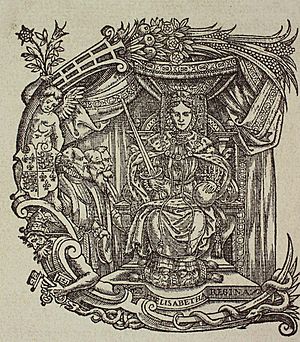British Constantine facts for kids
The "British Constantine" was a special idea used to praise two famous rulers: Queen Elizabeth I and King James I. It compared them to a powerful Roman Emperor named Constantine the Great.
This comparison had both political and religious meanings. Emperor Constantine was known for uniting the Roman Empire. He also made Christianity a major religion in his empire.
Constantine was also linked to an old Roman poem by Virgil, called the fourth Eclogue. Some people thought this poem predicted the coming of a Messiah (a savior). This idea connected Constantine to a future "Golden Age" of peace and prosperity.
Contents
Who was Constantine?
Many people in Britain, from the 1100s to the 1700s, believed that the Roman Emperor Constantine I was actually from Britain. This idea was very important in politics back then.
The story said that Constantine's mother, Helena of Constantinople, was British. However, there is no real historical proof for this. We know Constantine was in York in 306 AD when his father, Constantius Chlorus, died. Constantine was then declared Emperor there. But there's no evidence Helena was ever in Britain.
Old Stories and Legends
Early historians like William of Malmesbury and Henry of Huntingdon wrote about the "British Constantine" as if it were true. Henry of Huntingdon even said that King Coel of Colchester was Constantine's grandfather!
Later, Geoffrey of Monmouth added more details to this story in his book Historia regum Britanniae. He made King Coel a rebel and said Constantine was an ancestor of the famous King Arthur. This made Constantine a part of the "British myth," a collection of legendary stories about Britain's past.
Even though some historians, like Ralph de Diceto, stuck to the true Roman history of Constantine, many English historians accepted Geoffrey's version. The idea of Helena's British origins was even mentioned in a popular Christian book called the Golden Legend.
Ralph Higden wrote about Constantine's important role in Christianity. In the 1400s, a writer named Adam Usk claimed that Greeks believed they were descended from a "British Constantine." This idea was even used at the Council of Constance, a big meeting, to argue that England should have its own separate voice, not be grouped with Germany.
Tudors and Constantine
The early Tudor kings were very interested in the legends of King Arthur. For example, Henry VIII named his first son Arthur. But in 1533, Henry VIII decided to connect himself more with Constantine instead.
Historians like John Rous and Polydore Vergil helped link the Tudors to Constantine. Vergil's book, Historia Anglicana, didn't believe in the Arthurian legends, but it supported the idea of Helena's British origins. This connection helped strengthen the Tudor family's claims to the throne.
Elizabeth I as Constantine
People sometimes called Queen Elizabeth I a "British Constantine." This was a bit tricky because of England's relationship with Scotland.
John Foxe, a famous writer, compared Elizabeth to Constantine in his book Actes and Monuments. A picture in the 1563 edition of his book even showed her as a "second Constantine."
James I as Constantine
When King James I became king of England in 1603, a special medal was made. It had a Latin message saying he was "emperor of the whole island of Britain." This showed a clear link to Roman emperors like Constantine.
James faced some resistance from the English Parliament about using such a grand title. But comparisons to Roman emperors, including Constantine, continued. Later, a bishop named Joseph Hall gave a sermon praising James and comparing him to Constantine.
Many people still believed that Constantine's mother, Helena, was British. Writers like William Symonds even connected the House of Stuart (James's family) to Constantine. Some scholars, like James Maxwell, even suggested that James's son, Prince Charles, could be a "Last World Emperor," like Constantine.
Constantine was also famous for holding the First Council of Nicaea, a big meeting of Christian leaders in 325 AD. Since James I wanted to unite different Christian groups, comparing him to Constantine was a great compliment. However, some strict Protestants, called Puritans, didn't like this comparison because they wanted the church to be separate from the state.
Later Ideas About Constantine
Religious Views
As the 1600s went on, some Protestants started to view Constantine less favorably. For example, John Milton, a famous writer, believed that Constantine's reign marked the beginning of the Christian church losing its way.
Some thought Constantine was responsible for bishops becoming too ambitious. There were mixed feelings about Constantine. Some saw him as a good example of the state supporting the church, while others, like the Puritans, wanted the state to stay out of church matters.
Other Uses of the Comparison
An architect named Inigo Jones planned to build a structure in London based on Constantine's famous arch. It would have had a statue of King Charles I on top, but it was never built.
Later, people continued to compare kings to Constantine. For example, Henry Stubbe compared Charles II of England to Constantine. And Pierre Jurieu used the title for William III of England. In 1693, a book about William's military successes was even titled Constantinus redivivus, meaning "Constantine reborn."


